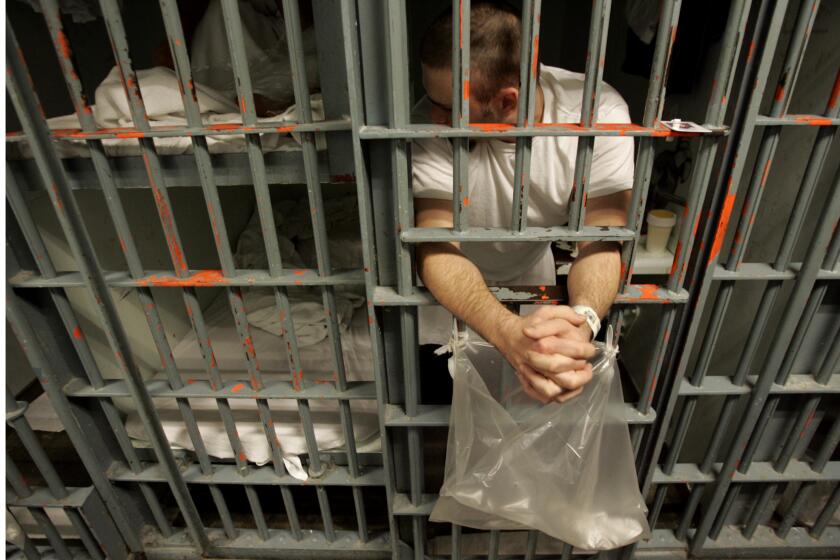For Los Angeles, list is a first step toward improved quake safety
The University of California’s release of data on nearly 1,500 older concrete buildings across Los Angeles marks a key step in the city’s efforts to improve earthquake safety.
Now the hard part begins.
UC researchers spent several years compiling the list of buildings, a first-of-its-kind effort to help identify a type of building that earthquake experts have long said poses the greatest risk of death.
Of all the older concrete buildings in Los Angeles, the researchers estimated that only about 75 would collapse during a huge quake.
But determining which ones are structurally at risk will require individual inspections.
Experts say the cost for just a preliminary examination could range from $4,000 to $20,000, depending on the size of the building. Retrofitting problem buildings would cost property owners much more, from the tens of thousands of dollars to perhaps more than $1 million for large office or residential towers.
The list underscores the scope of the challenge: More than 220,000 people live or work in the listed buildings, according to a Times analysis of the researchers’ data.
For city leaders, the next step is deciding how to inspect and repair the buildings — and who should cover the costs. Mayor Eric Garcetti has said getting quake-vulnerable concrete buildings retrofitted is a top priority and partnered with the U.S. Geological Survey to make recommendations on how to get it done.
Some City Council members have been exploring the idea of a state bond initiative to help defray some of the costs for building owners.
The University of California sent the list of addresses to the city Tuesday, after Los Angeles officials had asked for it. After months of debate about whether to make the list public, UC provided a copy to The Times in response to a public records act request.
The release of the list moves Los Angeles closer to addressing the dangers of concrete buildings after four decades of inaction.
Earlier efforts to identify and fix problem buildings died amid opposition from property owners after the 1994 Northridge quake. Concrete buildings collapsed during both that temblor and the 1971 Sylmar quake, in which hospital buildings crumbled, killing about 50 people.
Concrete buildings can be particularly vulnerable when they lack adequate steel reinforcement. As a result, their frames are brittle and can crumble during heavy shaking. Concrete buildings are found across Los Angeles but particularly in older commercial districts such as downtown, Hollywood and Mid-Wilshire. A Times survey last year found heavy concentrations of concrete residential towers and office buildings in those areas as well in Westwood and Encino.
Los Angeles is now the first city in California with a public list of older concrete buildings, and seismic safety experts said they hope this raises awareness of the issue.
“This challenge our communities face is now out in the open … and tells the community that something needs to be done,” said Craig Comartin, a structural engineer and past president of the Earthquake Engineering Research Institute, based in Oakland.
Some Los Angeles officials said the city must act by determining which buildings are actually at risk.
“We need to ensure that, as best as we can, that our residents are safe,” Councilman Bernard C. Parks said. “It’s absolutely important.”
Councilman Mitch Englander said the UC researchers’ work gives the city a rare opportunity to move forward, saying the city did not produce a list on its own “because of the political fallout, quite frankly.”
“What do you do with it, once you have it? That’s the million-dollar question,” he added.
Business groups and property owners have long opposed mandatory retrofitting, saying they cannot shoulder the costs alone.
The researchers emphasized that not all buildings on the list are necessarily vulnerable. Rather, it is a list of concrete structures built before 1976, identified through public records, maps and sidewalk surveys, that the researchers say would need to be further assessed to determine seismic safety.
The Times published a similar but more limited analysis last fall. Reporters mined city and county records to identify older concrete buildings and found more than 1,000 in Los Angeles.
The researchers cautioned that their list is not perfect and that some of the information gleaned from public records may be incorrect.
They said more work needs to be done to delete buildings that shouldn’t be on the list, as well as add ones that were missed.
UC Berkeley architecture professor Mary Comerio, one of the project’s lead scientists, said a major earthquake centered underneath downtown Los Angeles on the Puente Hills thrust fault could kill between 300 to 2,000 people in concrete buildings and cause about $20 billion in losses.
Retrofitting the buildings would reduce the projected death toll to five to 50 people and reduce losses to about $6 billion, said Comerio, whose research group was funded by a $3.6-million federal grant.
Past earthquakes around the world have shown that about 5% of older concrete buildings collapse in major quakes.
A Times analysis of the UC researchers’ data found that an estimated 229,000 Angelenos work and live in these buildings during the day, and about 48,000 at night.
Of the 1,451 buildings on the list, about 17% were classified as commercial, 15% industrial, 15% schools, 15% offices and 9% residential. The list also includes about four dozen hotels, four dozen churches and about two dozen nursing homes. The remainder fell into various other categories.
The buildings were in every part of Los Angeles — including each of the 15 City Council districts.
Councilman Jose Huizar’s district, which includes downtown, has the highest number of buildings on the list. About 66,750 people occupy more than 440 buildings during the daytime.
Also heavily affected is Hollywood, where about 26,930 people occupy more than 180 of the buildings during the day in the district represented by Councilman Mitch O’Farrell.
O’Farrell said in a statement that forcing owners to determine how their buildings were constructed would be a huge burden.
“This will create an incredible strain on our own resources as well as the financial resources of our constituents,” O’Farrell said. “Let’s be clear on one thing: These buildings in question were built decades ago and have withstood many earthquakes since then.”
Jeff Millman, a spokesman for Garcetti, said the mayor requested the list to help formulate a broader earthquake safety effort. “We are very interested in all research as we think about how to make buildings safer and prepare for the Big One,” he said.
Despite their sturdy appearance, older concrete buildings can be vulnerable to the sideways movement of a major earthquake when they don’t have enough steel reinforcing bars to hold columns in place.
To strengthen a building, steel beams can be added to surround the building, supporting it like an exoskeleton, or engineers can add sturdy concrete walls stretching from the ground to the roof.
A preliminary structural evaluation could cost as little as $4,000 for a simple, short building and as much as $20,000 for taller, more complicated structures, said Michael Cochran, president of the Structural Engineers Assn. of California.
Such an evaluation “would effectively eliminate a lot of the buildings that we wouldn’t have to evaluate further,” said David Cocke, who runs a structural engineering firm in Gardena.
Councilmen Parks and Englander said the city needs to take a closer look at the list and see if buildings need to be added or deleted. Parks and Councilman Tom LaBonge have introduced motions for the city to create its own census of older concrete buildings.
“It’s going to take time to verify it, bring in inspectors, look at what exactly needs to be inspected, get bodies trained to inspect them,” Englander said. “I believe the political will is there to do that.”
He also said it’s important to figure out ways to encourage property owners to want to deal with the issue — such as arranging a tax deduction for owners who invest in retrofitting. He is working with an assemblyman to introduce such a bill in the state Legislature.
Cities have developed inventories of other types of problem buildings and ordered fixes. In the 1980s, Los Angeles passed an ordinance requiring the retrofit or demolition of about 8,000 old brick buildings that could collapse during an earthquake.
San Francisco is now focusing on a different type of problem building: wooden apartment buildings with weak first stories. Last year, the city approved an ordinance requiring about 3,000 of the buildings to be retrofitted.
The researchers originally declined to release the building data to The Times last year, expressing concern that they could face lawsuits from property owners. But after the newspaper published its own, more limited survey in October, Garcetti instructed city officials to ask UC for its data. Researchers said they decided to provide it in hopes of helping L.A. improve earthquake safety.
Thalia Anagnos, a San Jose State engineering professor who worked on the concrete study, said property owners should be invited to participate in crafting a policy.
“The only way to do this is to include the community in the process,” she said.
More to Read
Sign up for Essential California
The most important California stories and recommendations in your inbox every morning.
You may occasionally receive promotional content from the Los Angeles Times.













